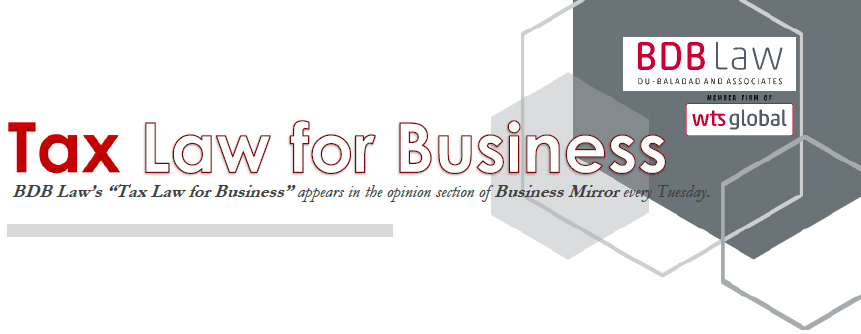
VAT Refunds
By: Atty. Mabel L. Buted
"The process in claiming for refund of excess and unutilized VAT in the Philippines has evolved throughout the years. The development was brought by the concerns and issues raised by various interested parties and affected groups, seeking to recover their excess input taxes paid."
 Mabel L. Buted +632 8403-2001 loc.160 |
Value-Added Tax (VAT) is a tax on the value added to the taxpayer. It is a tax imposed on the sale or exchange or lease of goods or properties or rendition of services and on importation of goods, as they pass along the production and distribution chain. It is a tax on consumption as this would be shifted or passed on to the buyer. Following the tax credit method, an entity can credit against the VAT charged on its sales or outputs the VAT paid on its purchases, inputs, and imports (G.R. No. 153866, February 11, 2005).
However, there are instances when VAT could no longer form part of the supply chain and be “consumed by the buyer,” such as when an entity is engaged in sales subject to 0% or is retiring from business. In these cases, there must be a way to recover the VAT paid on the purchases, and that way is through the process of refund. Refund is a remedy available also in the county.
 The process in claiming for refund of excess and unutilized VAT in the Philippines has evolved throughout the years. The development was brought by the concerns and issues raised by various interested parties and affected groups, seeking to recover their excess input taxes paid. Here is an outline of the current rules and procedures in the application for input VAT refund and processing of claims.
The process in claiming for refund of excess and unutilized VAT in the Philippines has evolved throughout the years. The development was brought by the concerns and issues raised by various interested parties and affected groups, seeking to recover their excess input taxes paid. Here is an outline of the current rules and procedures in the application for input VAT refund and processing of claims.
Only persons and entities registered as VAT taxpayers can claim for refund. At the same time, they must be engaged in sales of goods and services that are subject to 0% VAT. These include entities whose sales are effectively subject to 0% VAT under special laws, like the Renewable Energy Developers. In addition, a person whose registration has been cancelled due to retirement from or cessation of business, or due to changes in or cessation of status as a VAT-registered taxpayer can also apply for refund.
Only input taxes attributable to VAT zero-rated sales can be refunded. In case of retirement or closure of business, only input taxes that were not applied against output taxes can be recovered.
The claim for refund must be filed with the VAT Credit Audit Division (VCAD), with the VAT Audit Section/Unit in the Regional Assessment Division or Large Taxpayers Service, or with the Revenue District Office where the taxpayer is registered.
Taxpayers have two (2) years after the close of the taxable quarter when the sales are made to apply for tax refund. In case of claim for refund due to cancellation of registration, the two-year period will commence from the date of issuance of tax clearance by the BIR, after full settlement of all tax liabilities.
From the date of submission of the supporting invoices and other documents, the BIR has 90 days to decide on the application. In case the claim is denied, partial or full, the taxpayer has 15 days from receipt of the decision to file a request for reconsideration with the Commissioner of Internal Revenue. Thereafter, the Commissioner will decide on the appeal within another 15 days. In case the request for reconsideration is denied or in case the CIR failed to act on the claim for refund or the request for reconsideration within the 90-day period or 15-day period, the taxpayer has 30 days to appeal the decision or the inaction with the Court of Tax Appeals.
The BIR adopts a risk-based approach in verifying VAT refund claims. The claims shall be classified into low-, medium-, and high-risk claims. The risk classification will be based on certain factors such as the amount of the claim, history of tax compliance, and frequency of filing of the taxpayer. However, the following are automatically classified as high-risk claims under BIR revenue issuances: (a) first-time claimants for the succeeding three (3) VAT refund claims; (b) fourth (4th) claim following three (3) consecutive low-risk classification of processed VAT refund claims; (c) succeeding claim following a full denial; (d) VAT refund claims arising from retirement/cessation of business; (e) applications covering more than one taxable quarter, where at least one taxable quarter is already prescribed; (f) claims of “Cannot be Located” taxpayers; and (g) claims of taxpayers with complaints filed at the Department of Justice and/or those with criminal cases before the courts under the Run After Tax Evaders (RATE) and Run After Fake Transactions (RAFT) programs of the BIR.
Only claims considered as medium-risk and high-risk are subject to verification. Low-risk claims are not subject to tax audit. In medium-risk claims, the BIR can verify only at least 50% of the amount of the taxpayer’s sales, purchases, and documents. On the other hand, in high-risk claims, the BIR will audit 100% of the sales, purchases, and documents.
The author is a partner of Du-Baladad and Associates Law Offices (BDB Law), a member-firm of WTS Global.
The article is for general information only and is not intended, nor should be construed as a substitute for tax, legal or financial advice on any specific matter. Applicability of this article to any actual or particular tax or legal issue should be supported therefore by a professional study or advice. If you have any comments or questions concerning the article, you may e-mail the author at This email address is being protected from spambots. You need JavaScript enabled to view it. or call 8403-2001 local 160.




